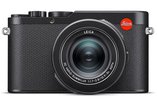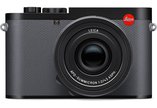
-
JOIN OUR WAITLIST
You've been added. Thank You!
×Leica Q3




4 Day Rental Price:
$272.00
The Leica Q3 is a full-frame compact camera with a fixed 28mm f/1.7 lens and an update to the Leica Q2. Key features include:
-
60MP full-frame sensor with MAESTRO IV image processor
-
Fixed Summilux 28mm f/1.7 lens
-
Hybrid autofocus system
-
8K30, 4K60, ProRes 1080p recording
What’s Changed? The Leica Q3 may look and feel quite similar to the Q2, but a great deal of improvements work their way into this compact, sleek camera. In a chassis almost identical in size and weight to its predecessor, the Q3 flaunts an updated 60MP full-frame CMOS sensor, the Maestro IV processor, hybrid autofocus that enables intelligent subject recognition to track eyes, faces, bodies, and animals in fast-paced or mixed lightning conditions, and boasts DCI 8K recording at 30fps with 10-bit color. In fact, so many features have been upgraded that it would be better to ask what hasn’t changed.
What Hasn’t Changed? Glad you asked. The design of the Leica Q3 is similar to the Q2, but the biggest similarity between the two is the fixed lens. The specially-designed Summilux 28mm f/1.7 ASPH lens is a wide-angle lens designed to work in a variety of environmental and lightning conditions, refined to capture sharp images with minimal distortion in a compact profile that still offers tactical focus and aperture adjustments, a switch to enable focusing on subjects as close as 6.7 inches away, and optical image stabilization.
Superb Performance. If the technical specs of the updated sensor on this camera sound familiar, that’s because it’s the exact same sensor found on the more premium Leica M11. At 60MP, the back-illuminated design features improved noise performance, especially in low-light environments where you might use a higher ISO. The high resolution favors detail-centric images, perfect for landscape or architecture shoots. With such a high resolution, you can simulate different focal lengths, from the native 28mm all the way to 90mm, while retaining image quality. Triple Resolution Technology, also found on the M11, allows you to output at 60, 36, or 18MP with 14-bit color and a 14-stop dynamic range.
Maestro IV. The Maestro IV debuts inside the Q3 with 8GB of buffer memory to provide fast processing to increase speed when shooting both stills and video as well as improving Triple Resolution Technology performance, enabling an ISO range of 50 to 100,000.
Hybrid Autofocus. Contrast-detection, phase-detection, and depth from defocus autofocus combine to create a powerful hybrid autofocusing system that works faster and better when capturing moving subjects or working with mixed lightning. The intelligent subject recognition system tracks eyes, faces, bodies, and animals with ease.
Too Sharp. The Leica Q3 now supports 8K30 video capture, which is probably more than you need, but so cool to have. If you stick with 4K, you’ll enjoy up to 60p recordings internally or externally. ProRes 422 HQ recording is even possible, but you’ll be limited to 1080p60. The included Micro-HDMI and USB-C ports allow you to pair external recorders, gimbals, or even a power bank (yes, you can charge the camera via USB-C!) for more complex setups.
Design Updates. While the basic dimensions of the Q3 remain the same as its predecessor, it does boast design improvements, including a 5.76m-dot OLED electronic viewfinder with a 120fps refresh rate as well as a tilting, touchscreen LCD that can face up or down. The magnesium alloy body is IP52 rated against dust and moisture for harsher environments.
Powerful. The BP-SCL6 battery provides 350 shots per charge, but the Q3 will still work with its predecessor, the BP-SCL4. A USB-C 3.1 port can transfer, tether, and charge both the camera and battery, and is certified to work with iPhones. If you’ve made it this far and want more features, this camera even supports wireless charging when paired with the HG-DC1 handgrip (not included.) That’s right- you can wirelessly charge your camera.
Q & A
- I heard this camera charges wirelessly- is that true?
-
That’s right- you can wirelessly charge your camera if you pair it with the HG-DC1 handgrip.
-
- Will the Leica Q2 batteries work with this camera?
-
Yes! This camera comes with an updated BP-SCL6 battery, but will still work with the BP-SCL4.
Resources
-
- Manual
- Quick Start Guide
| Audio Recording |
48-Bit 16 kHz AAC Audio |
| Bit Depth |
14-Bit |
| Brand |
Leica |
| Camera Type |
Compact |
| Dimensions |
5.1 × 3.2 × 3.6″ |
| Exposure Compensation |
-3 to +3 EV (1/3 EV Steps) |
| External Video Recording Modes |
4:2:0 8-Bit via HDMI
|
| Filter Size |
49 mm (Front) |
| Focal Length |
28mm |
| ISO Range |
50 to 100,000 in Manual Mode |
| Image Sensor |
35.8 × 23.9 mm (Full-Frame) CMOS |
| Image Stabilization |
Optical in Integrated Lens |
| Internal Video Recording Modes |
H.265 Long GOP/MOV 4:2:0 10-Bit
|
| Item Type |
Camera |
| Maximum Aperture |
f/1.7 |
| Memory Card Slot |
Single Slot: SD/SDHC/SDXC (UHS-II) |
| Minimum Aperture |
f/16 |
| Mount |
Leica M |
| Other I/O |
1 x USB-C (USB 3.2 / 3.1 Gen 2) Input/Output (Shared with Power Input) |
| Power Input |
1 x USB-C Input |
| Sensor Resolution |
Actual: 62.39 Megapixel |
| Video Inputs |
1 x Micro-HDMI Output |
| Weight |
1.6 lb |
































